Report: Evaluation of Cloud Computing Adoption at BDG, Australia
VerifiedAdded on 2019/11/25
|15
|3741
|273
Report
AI Summary
This report evaluates the adoption of cloud computing services for Blood Donation Group (BDG), a significant blood product supplier in Australia. It analyzes the benefits, such as cost reduction and scalability, and the challenges, including cybersecurity risks and regulatory compliance. The report uses a cost-benefit analysis model to assess the financial implications of cloud adoption and its relevance to BDG's operational issues, such as ERP system maintenance and donor data access. It identifies potential cyber security threats like data loss and compliance violations, proposing solutions for secure cloud implementation. Furthermore, the report recommends suitable cloud vendors for BDG, considering their service offerings and security measures to address the organization's specific needs. Ultimately, the report provides a strategic overview of cloud adoption, offering insights into its feasibility and benefits for BDG's business operations.
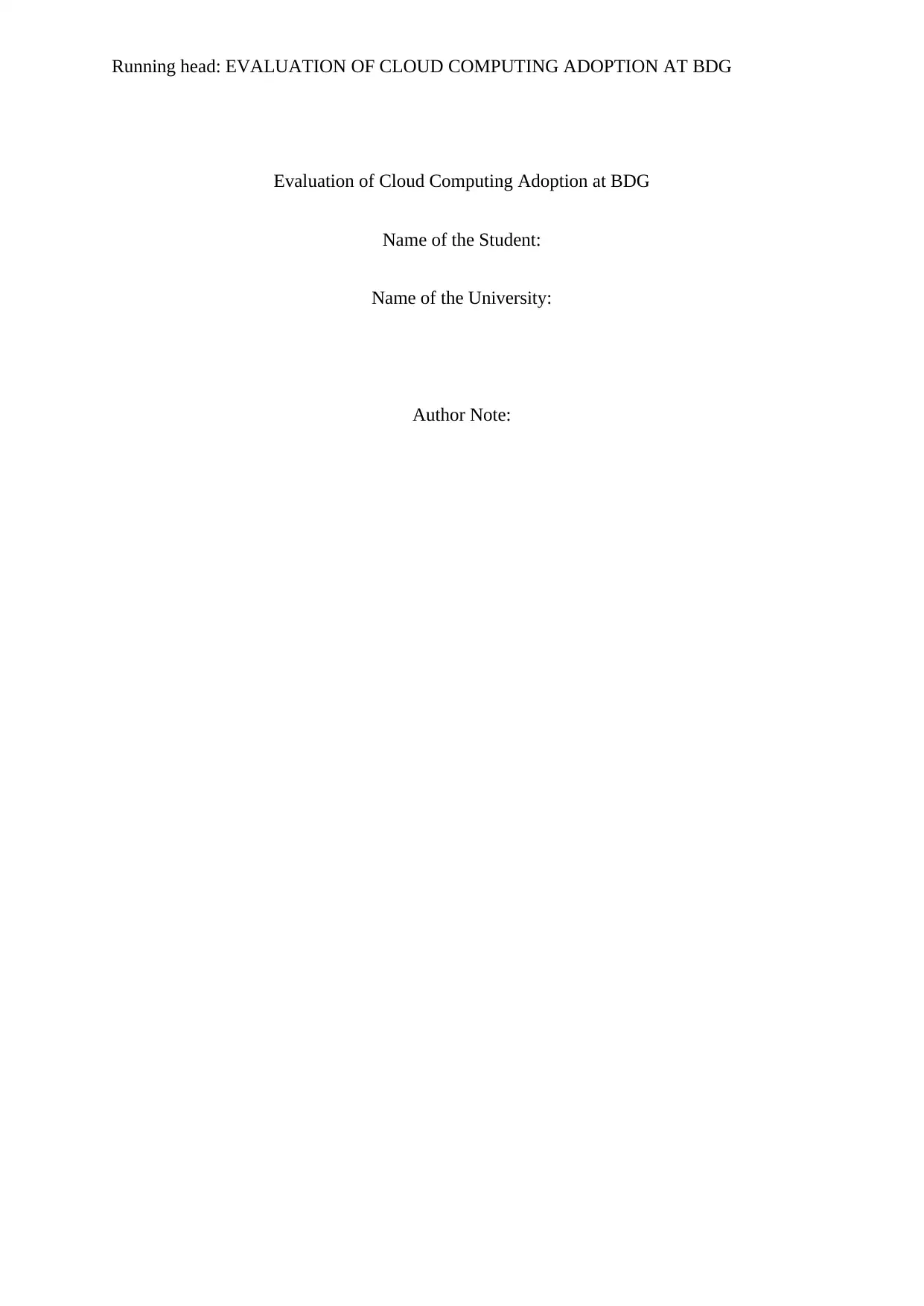
Running head: EVALUATION OF CLOUD COMPUTING ADOPTION AT BDG
Evaluation of Cloud Computing Adoption at BDG
Name of the Student:
Name of the University:
Author Note:
Evaluation of Cloud Computing Adoption at BDG
Name of the Student:
Name of the University:
Author Note:
Paraphrase This Document
Need a fresh take? Get an instant paraphrase of this document with our AI Paraphraser
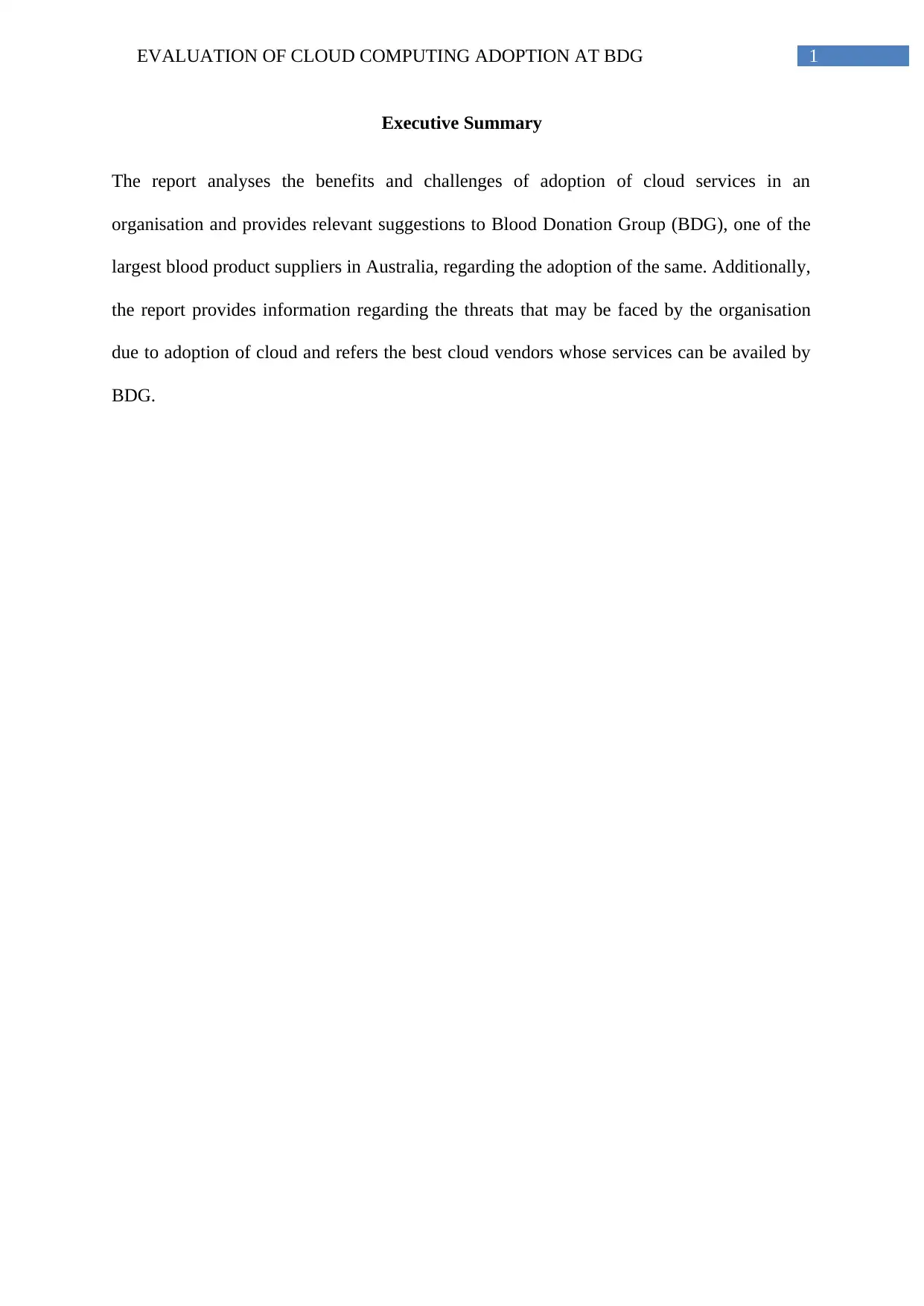
1EVALUATION OF CLOUD COMPUTING ADOPTION AT BDG
Executive Summary
The report analyses the benefits and challenges of adoption of cloud services in an
organisation and provides relevant suggestions to Blood Donation Group (BDG), one of the
largest blood product suppliers in Australia, regarding the adoption of the same. Additionally,
the report provides information regarding the threats that may be faced by the organisation
due to adoption of cloud and refers the best cloud vendors whose services can be availed by
BDG.
Executive Summary
The report analyses the benefits and challenges of adoption of cloud services in an
organisation and provides relevant suggestions to Blood Donation Group (BDG), one of the
largest blood product suppliers in Australia, regarding the adoption of the same. Additionally,
the report provides information regarding the threats that may be faced by the organisation
due to adoption of cloud and refers the best cloud vendors whose services can be availed by
BDG.
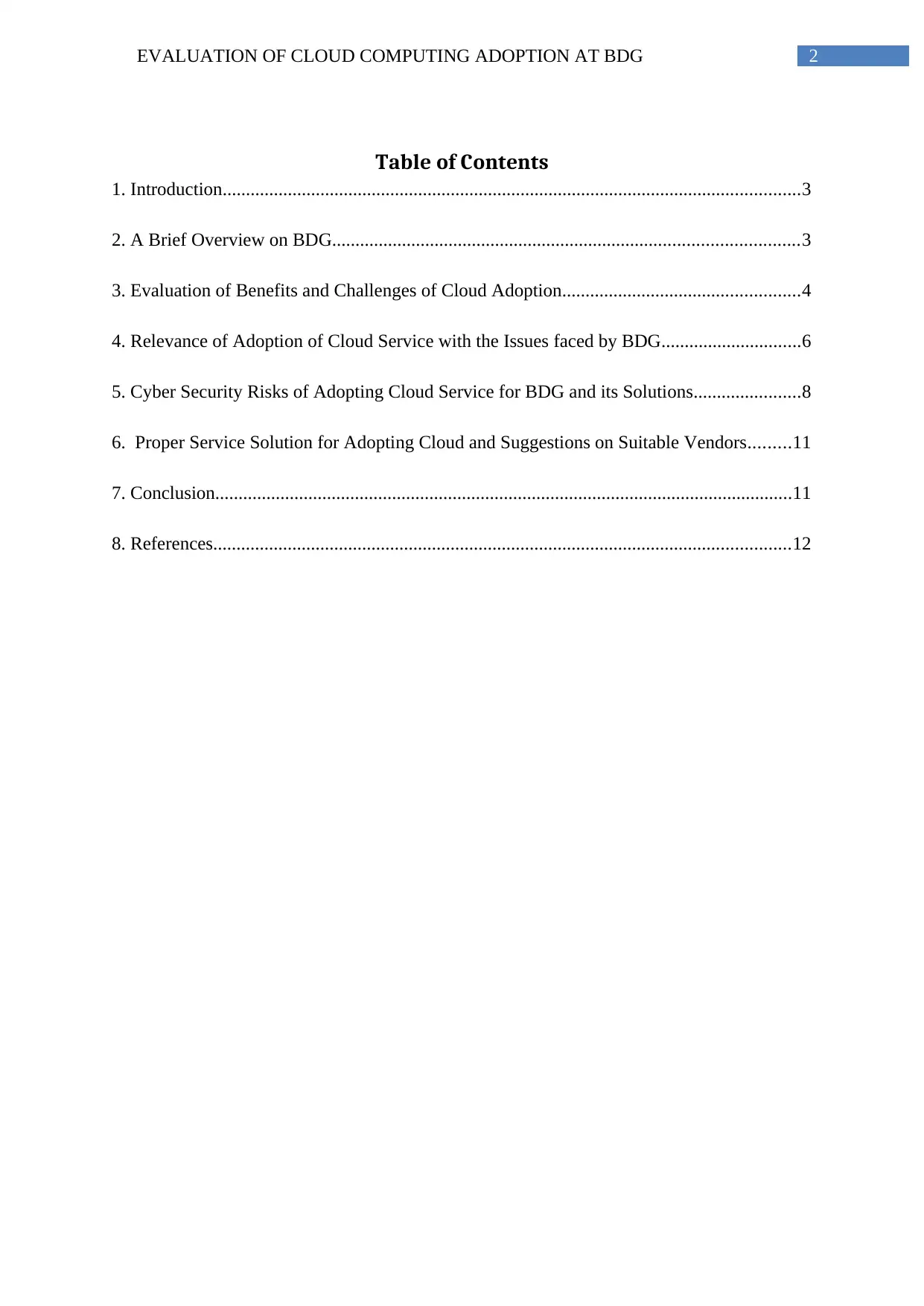
2EVALUATION OF CLOUD COMPUTING ADOPTION AT BDG
Table of Contents
1. Introduction............................................................................................................................3
2. A Brief Overview on BDG....................................................................................................3
3. Evaluation of Benefits and Challenges of Cloud Adoption...................................................4
4. Relevance of Adoption of Cloud Service with the Issues faced by BDG..............................6
5. Cyber Security Risks of Adopting Cloud Service for BDG and its Solutions.......................8
6. Proper Service Solution for Adopting Cloud and Suggestions on Suitable Vendors.........11
7. Conclusion............................................................................................................................11
8. References............................................................................................................................12
Table of Contents
1. Introduction............................................................................................................................3
2. A Brief Overview on BDG....................................................................................................3
3. Evaluation of Benefits and Challenges of Cloud Adoption...................................................4
4. Relevance of Adoption of Cloud Service with the Issues faced by BDG..............................6
5. Cyber Security Risks of Adopting Cloud Service for BDG and its Solutions.......................8
6. Proper Service Solution for Adopting Cloud and Suggestions on Suitable Vendors.........11
7. Conclusion............................................................................................................................11
8. References............................................................................................................................12
⊘ This is a preview!⊘
Do you want full access?
Subscribe today to unlock all pages.

Trusted by 1+ million students worldwide
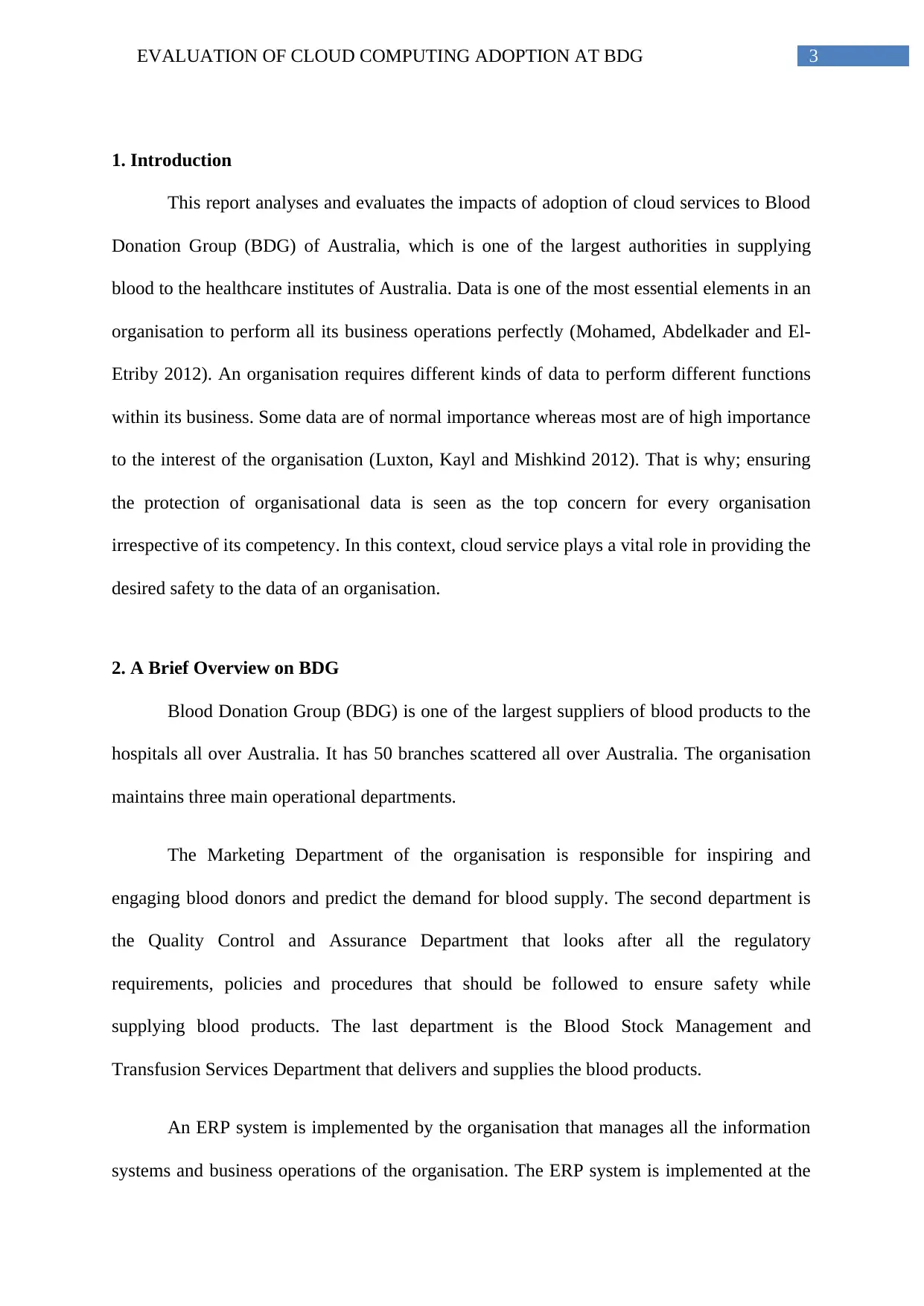
3EVALUATION OF CLOUD COMPUTING ADOPTION AT BDG
1. Introduction
This report analyses and evaluates the impacts of adoption of cloud services to Blood
Donation Group (BDG) of Australia, which is one of the largest authorities in supplying
blood to the healthcare institutes of Australia. Data is one of the most essential elements in an
organisation to perform all its business operations perfectly (Mohamed, Abdelkader and El-
Etriby 2012). An organisation requires different kinds of data to perform different functions
within its business. Some data are of normal importance whereas most are of high importance
to the interest of the organisation (Luxton, Kayl and Mishkind 2012). That is why; ensuring
the protection of organisational data is seen as the top concern for every organisation
irrespective of its competency. In this context, cloud service plays a vital role in providing the
desired safety to the data of an organisation.
2. A Brief Overview on BDG
Blood Donation Group (BDG) is one of the largest suppliers of blood products to the
hospitals all over Australia. It has 50 branches scattered all over Australia. The organisation
maintains three main operational departments.
The Marketing Department of the organisation is responsible for inspiring and
engaging blood donors and predict the demand for blood supply. The second department is
the Quality Control and Assurance Department that looks after all the regulatory
requirements, policies and procedures that should be followed to ensure safety while
supplying blood products. The last department is the Blood Stock Management and
Transfusion Services Department that delivers and supplies the blood products.
An ERP system is implemented by the organisation that manages all the information
systems and business operations of the organisation. The ERP system is implemented at the
1. Introduction
This report analyses and evaluates the impacts of adoption of cloud services to Blood
Donation Group (BDG) of Australia, which is one of the largest authorities in supplying
blood to the healthcare institutes of Australia. Data is one of the most essential elements in an
organisation to perform all its business operations perfectly (Mohamed, Abdelkader and El-
Etriby 2012). An organisation requires different kinds of data to perform different functions
within its business. Some data are of normal importance whereas most are of high importance
to the interest of the organisation (Luxton, Kayl and Mishkind 2012). That is why; ensuring
the protection of organisational data is seen as the top concern for every organisation
irrespective of its competency. In this context, cloud service plays a vital role in providing the
desired safety to the data of an organisation.
2. A Brief Overview on BDG
Blood Donation Group (BDG) is one of the largest suppliers of blood products to the
hospitals all over Australia. It has 50 branches scattered all over Australia. The organisation
maintains three main operational departments.
The Marketing Department of the organisation is responsible for inspiring and
engaging blood donors and predict the demand for blood supply. The second department is
the Quality Control and Assurance Department that looks after all the regulatory
requirements, policies and procedures that should be followed to ensure safety while
supplying blood products. The last department is the Blood Stock Management and
Transfusion Services Department that delivers and supplies the blood products.
An ERP system is implemented by the organisation that manages all the information
systems and business operations of the organisation. The ERP system is implemented at the
Paraphrase This Document
Need a fresh take? Get an instant paraphrase of this document with our AI Paraphraser
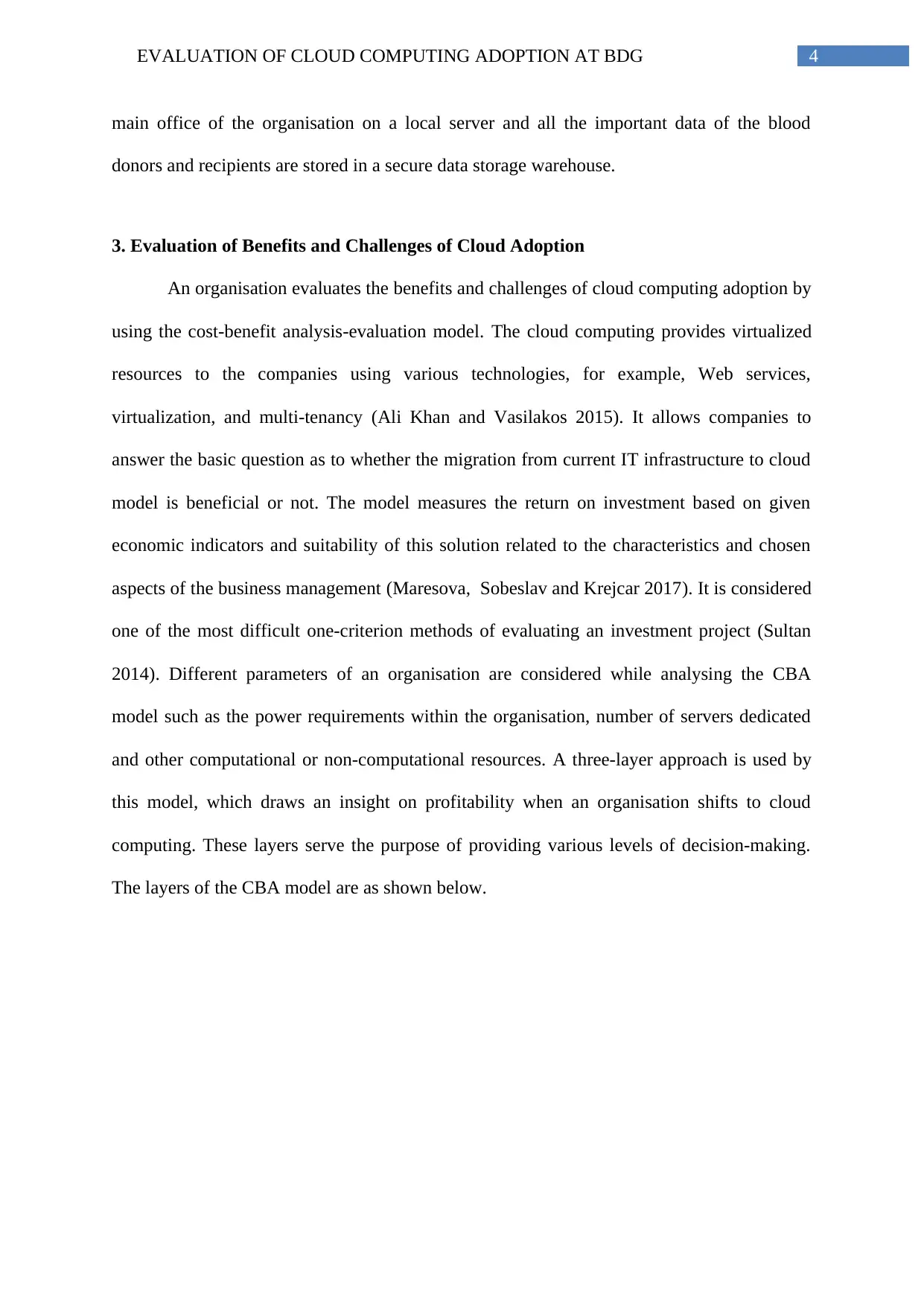
4EVALUATION OF CLOUD COMPUTING ADOPTION AT BDG
main office of the organisation on a local server and all the important data of the blood
donors and recipients are stored in a secure data storage warehouse.
3. Evaluation of Benefits and Challenges of Cloud Adoption
An organisation evaluates the benefits and challenges of cloud computing adoption by
using the cost-benefit analysis-evaluation model. The cloud computing provides virtualized
resources to the companies using various technologies, for example, Web services,
virtualization, and multi-tenancy (Ali Khan and Vasilakos 2015). It allows companies to
answer the basic question as to whether the migration from current IT infrastructure to cloud
model is beneficial or not. The model measures the return on investment based on given
economic indicators and suitability of this solution related to the characteristics and chosen
aspects of the business management (Maresova, Sobeslav and Krejcar 2017). It is considered
one of the most difficult one-criterion methods of evaluating an investment project (Sultan
2014). Different parameters of an organisation are considered while analysing the CBA
model such as the power requirements within the organisation, number of servers dedicated
and other computational or non-computational resources. A three-layer approach is used by
this model, which draws an insight on profitability when an organisation shifts to cloud
computing. These layers serve the purpose of providing various levels of decision-making.
The layers of the CBA model are as shown below.
main office of the organisation on a local server and all the important data of the blood
donors and recipients are stored in a secure data storage warehouse.
3. Evaluation of Benefits and Challenges of Cloud Adoption
An organisation evaluates the benefits and challenges of cloud computing adoption by
using the cost-benefit analysis-evaluation model. The cloud computing provides virtualized
resources to the companies using various technologies, for example, Web services,
virtualization, and multi-tenancy (Ali Khan and Vasilakos 2015). It allows companies to
answer the basic question as to whether the migration from current IT infrastructure to cloud
model is beneficial or not. The model measures the return on investment based on given
economic indicators and suitability of this solution related to the characteristics and chosen
aspects of the business management (Maresova, Sobeslav and Krejcar 2017). It is considered
one of the most difficult one-criterion methods of evaluating an investment project (Sultan
2014). Different parameters of an organisation are considered while analysing the CBA
model such as the power requirements within the organisation, number of servers dedicated
and other computational or non-computational resources. A three-layer approach is used by
this model, which draws an insight on profitability when an organisation shifts to cloud
computing. These layers serve the purpose of providing various levels of decision-making.
The layers of the CBA model are as shown below.

5EVALUATION OF CLOUD COMPUTING ADOPTION AT BDG
Figure 1: Cost-Benefit Analysis Model
(Source: Scholarworks.lib.csusb.edu 2017)
Layer 1 – This layer specifies the overall base cost as shown in the figure above. This
layer is designed to analyse the monthly cost that is required to maintain the IT infrastructure
of an organisation depending on parameters that will help in decision-making regarding the
adoption of cloud services. The total base cost is compared with the final cost that is required
to adopt cloud service.
Layer 2 – This layer is not dependent on the costs involved in maintenance of the
internal infrastructure of an organisation and therefore, is not compared with the costs
required to implement cloud in the same. A couple of analysis is made in the layer that helps
Figure 1: Cost-Benefit Analysis Model
(Source: Scholarworks.lib.csusb.edu 2017)
Layer 1 – This layer specifies the overall base cost as shown in the figure above. This
layer is designed to analyse the monthly cost that is required to maintain the IT infrastructure
of an organisation depending on parameters that will help in decision-making regarding the
adoption of cloud services. The total base cost is compared with the final cost that is required
to adopt cloud service.
Layer 2 – This layer is not dependent on the costs involved in maintenance of the
internal infrastructure of an organisation and therefore, is not compared with the costs
required to implement cloud in the same. A couple of analysis is made in the layer that helps
⊘ This is a preview!⊘
Do you want full access?
Subscribe today to unlock all pages.

Trusted by 1+ million students worldwide
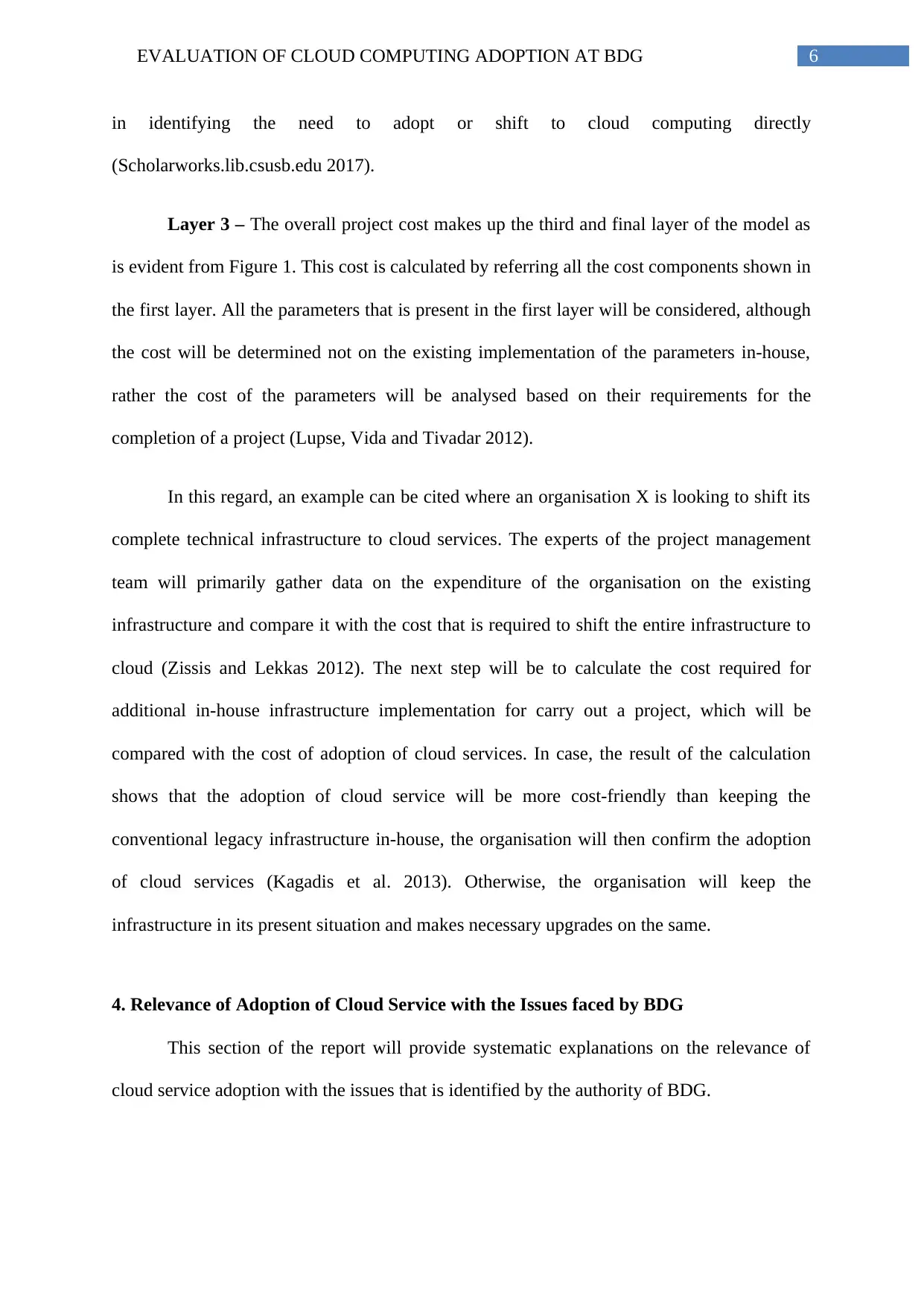
6EVALUATION OF CLOUD COMPUTING ADOPTION AT BDG
in identifying the need to adopt or shift to cloud computing directly
(Scholarworks.lib.csusb.edu 2017).
Layer 3 – The overall project cost makes up the third and final layer of the model as
is evident from Figure 1. This cost is calculated by referring all the cost components shown in
the first layer. All the parameters that is present in the first layer will be considered, although
the cost will be determined not on the existing implementation of the parameters in-house,
rather the cost of the parameters will be analysed based on their requirements for the
completion of a project (Lupse, Vida and Tivadar 2012).
In this regard, an example can be cited where an organisation X is looking to shift its
complete technical infrastructure to cloud services. The experts of the project management
team will primarily gather data on the expenditure of the organisation on the existing
infrastructure and compare it with the cost that is required to shift the entire infrastructure to
cloud (Zissis and Lekkas 2012). The next step will be to calculate the cost required for
additional in-house infrastructure implementation for carry out a project, which will be
compared with the cost of adoption of cloud services. In case, the result of the calculation
shows that the adoption of cloud service will be more cost-friendly than keeping the
conventional legacy infrastructure in-house, the organisation will then confirm the adoption
of cloud services (Kagadis et al. 2013). Otherwise, the organisation will keep the
infrastructure in its present situation and makes necessary upgrades on the same.
4. Relevance of Adoption of Cloud Service with the Issues faced by BDG
This section of the report will provide systematic explanations on the relevance of
cloud service adoption with the issues that is identified by the authority of BDG.
in identifying the need to adopt or shift to cloud computing directly
(Scholarworks.lib.csusb.edu 2017).
Layer 3 – The overall project cost makes up the third and final layer of the model as
is evident from Figure 1. This cost is calculated by referring all the cost components shown in
the first layer. All the parameters that is present in the first layer will be considered, although
the cost will be determined not on the existing implementation of the parameters in-house,
rather the cost of the parameters will be analysed based on their requirements for the
completion of a project (Lupse, Vida and Tivadar 2012).
In this regard, an example can be cited where an organisation X is looking to shift its
complete technical infrastructure to cloud services. The experts of the project management
team will primarily gather data on the expenditure of the organisation on the existing
infrastructure and compare it with the cost that is required to shift the entire infrastructure to
cloud (Zissis and Lekkas 2012). The next step will be to calculate the cost required for
additional in-house infrastructure implementation for carry out a project, which will be
compared with the cost of adoption of cloud services. In case, the result of the calculation
shows that the adoption of cloud service will be more cost-friendly than keeping the
conventional legacy infrastructure in-house, the organisation will then confirm the adoption
of cloud services (Kagadis et al. 2013). Otherwise, the organisation will keep the
infrastructure in its present situation and makes necessary upgrades on the same.
4. Relevance of Adoption of Cloud Service with the Issues faced by BDG
This section of the report will provide systematic explanations on the relevance of
cloud service adoption with the issues that is identified by the authority of BDG.
Paraphrase This Document
Need a fresh take? Get an instant paraphrase of this document with our AI Paraphraser
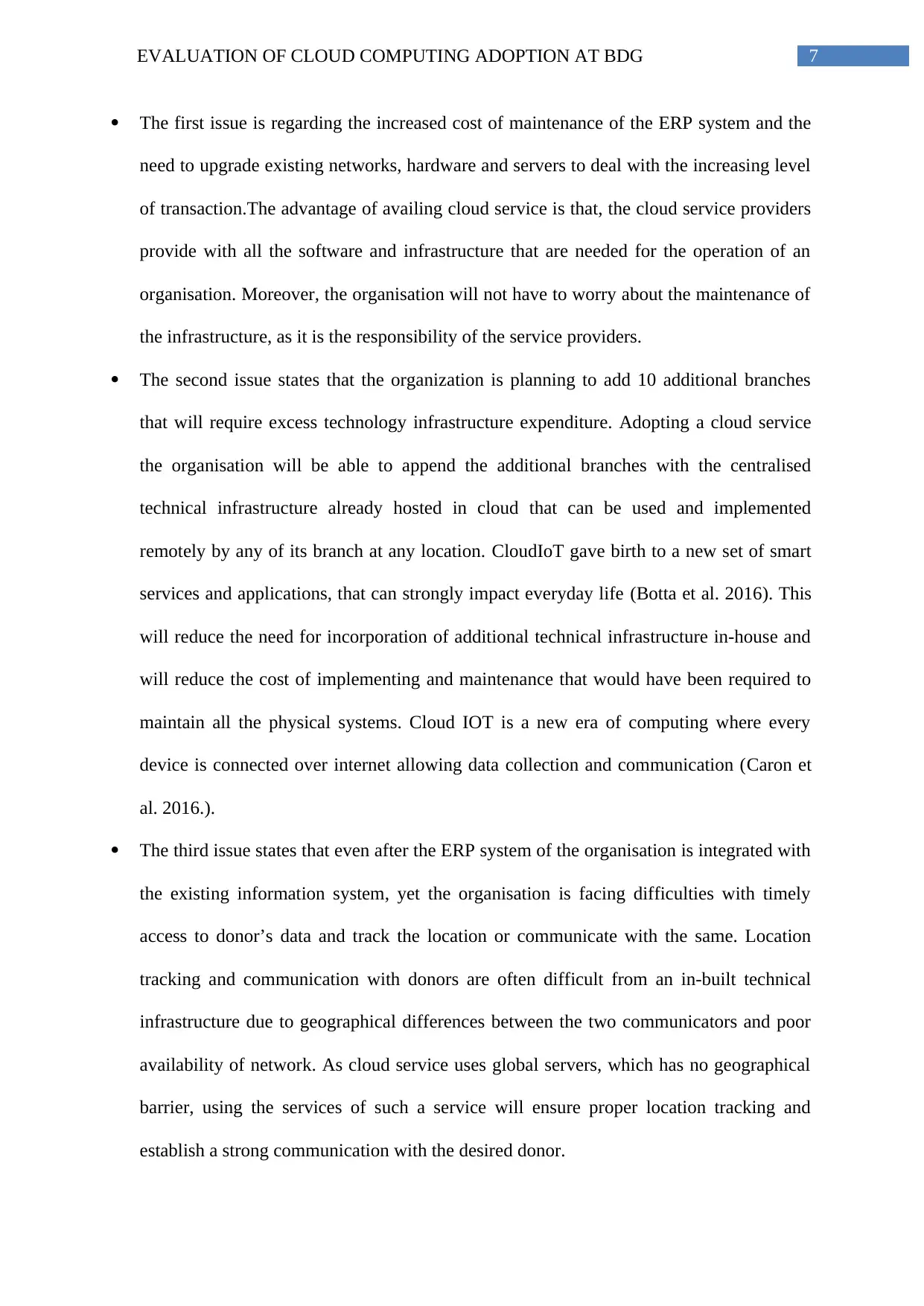
7EVALUATION OF CLOUD COMPUTING ADOPTION AT BDG
The first issue is regarding the increased cost of maintenance of the ERP system and the
need to upgrade existing networks, hardware and servers to deal with the increasing level
of transaction.The advantage of availing cloud service is that, the cloud service providers
provide with all the software and infrastructure that are needed for the operation of an
organisation. Moreover, the organisation will not have to worry about the maintenance of
the infrastructure, as it is the responsibility of the service providers.
The second issue states that the organization is planning to add 10 additional branches
that will require excess technology infrastructure expenditure. Adopting a cloud service
the organisation will be able to append the additional branches with the centralised
technical infrastructure already hosted in cloud that can be used and implemented
remotely by any of its branch at any location. CloudIoT gave birth to a new set of smart
services and applications, that can strongly impact everyday life (Botta et al. 2016). This
will reduce the need for incorporation of additional technical infrastructure in-house and
will reduce the cost of implementing and maintenance that would have been required to
maintain all the physical systems. Cloud IOT is a new era of computing where every
device is connected over internet allowing data collection and communication (Caron et
al. 2016.).
The third issue states that even after the ERP system of the organisation is integrated with
the existing information system, yet the organisation is facing difficulties with timely
access to donor’s data and track the location or communicate with the same. Location
tracking and communication with donors are often difficult from an in-built technical
infrastructure due to geographical differences between the two communicators and poor
availability of network. As cloud service uses global servers, which has no geographical
barrier, using the services of such a service will ensure proper location tracking and
establish a strong communication with the desired donor.
The first issue is regarding the increased cost of maintenance of the ERP system and the
need to upgrade existing networks, hardware and servers to deal with the increasing level
of transaction.The advantage of availing cloud service is that, the cloud service providers
provide with all the software and infrastructure that are needed for the operation of an
organisation. Moreover, the organisation will not have to worry about the maintenance of
the infrastructure, as it is the responsibility of the service providers.
The second issue states that the organization is planning to add 10 additional branches
that will require excess technology infrastructure expenditure. Adopting a cloud service
the organisation will be able to append the additional branches with the centralised
technical infrastructure already hosted in cloud that can be used and implemented
remotely by any of its branch at any location. CloudIoT gave birth to a new set of smart
services and applications, that can strongly impact everyday life (Botta et al. 2016). This
will reduce the need for incorporation of additional technical infrastructure in-house and
will reduce the cost of implementing and maintenance that would have been required to
maintain all the physical systems. Cloud IOT is a new era of computing where every
device is connected over internet allowing data collection and communication (Caron et
al. 2016.).
The third issue states that even after the ERP system of the organisation is integrated with
the existing information system, yet the organisation is facing difficulties with timely
access to donor’s data and track the location or communicate with the same. Location
tracking and communication with donors are often difficult from an in-built technical
infrastructure due to geographical differences between the two communicators and poor
availability of network. As cloud service uses global servers, which has no geographical
barrier, using the services of such a service will ensure proper location tracking and
establish a strong communication with the desired donor.
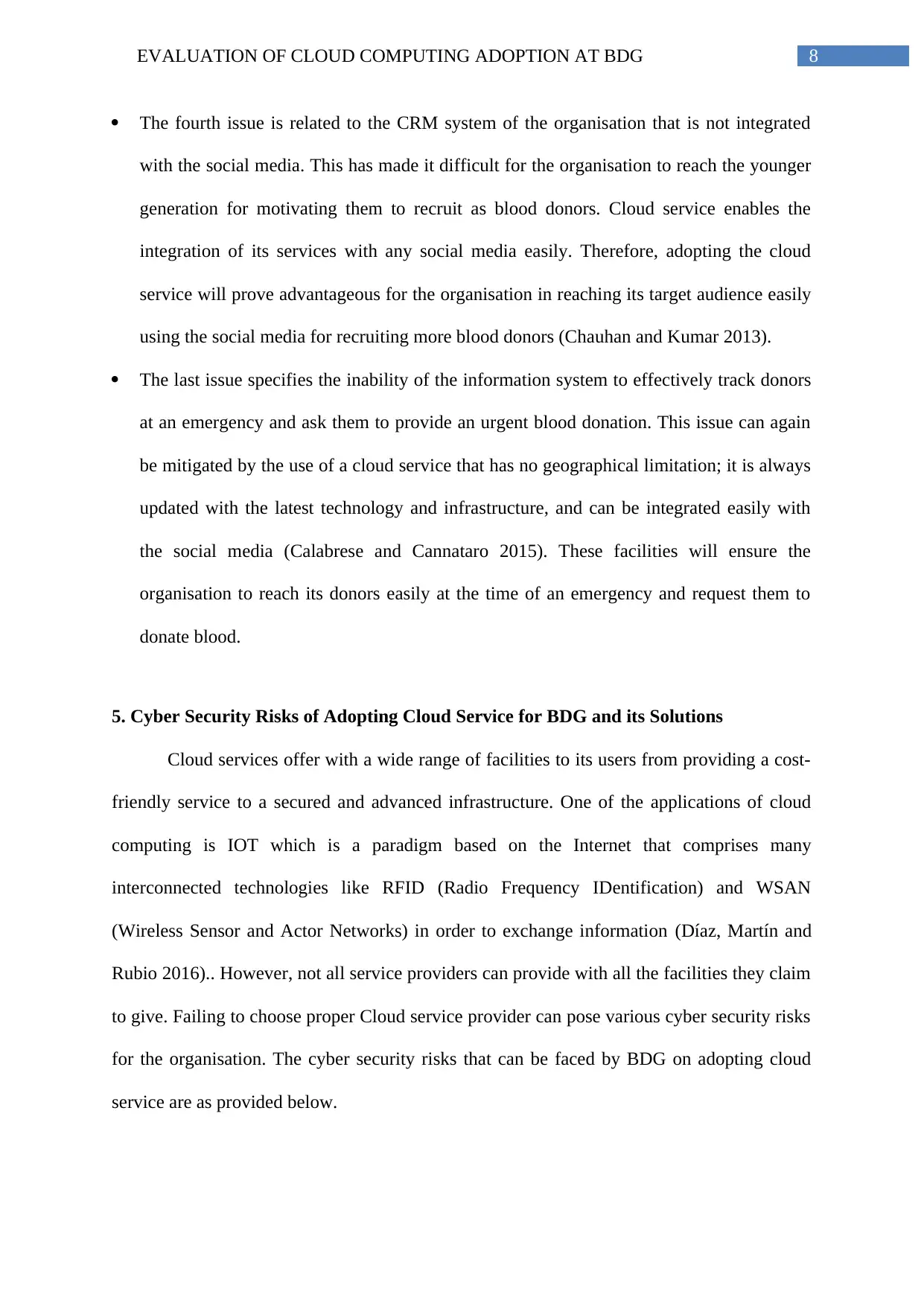
8EVALUATION OF CLOUD COMPUTING ADOPTION AT BDG
The fourth issue is related to the CRM system of the organisation that is not integrated
with the social media. This has made it difficult for the organisation to reach the younger
generation for motivating them to recruit as blood donors. Cloud service enables the
integration of its services with any social media easily. Therefore, adopting the cloud
service will prove advantageous for the organisation in reaching its target audience easily
using the social media for recruiting more blood donors (Chauhan and Kumar 2013).
The last issue specifies the inability of the information system to effectively track donors
at an emergency and ask them to provide an urgent blood donation. This issue can again
be mitigated by the use of a cloud service that has no geographical limitation; it is always
updated with the latest technology and infrastructure, and can be integrated easily with
the social media (Calabrese and Cannataro 2015). These facilities will ensure the
organisation to reach its donors easily at the time of an emergency and request them to
donate blood.
5. Cyber Security Risks of Adopting Cloud Service for BDG and its Solutions
Cloud services offer with a wide range of facilities to its users from providing a cost-
friendly service to a secured and advanced infrastructure. One of the applications of cloud
computing is IOT which is a paradigm based on the Internet that comprises many
interconnected technologies like RFID (Radio Frequency IDentification) and WSAN
(Wireless Sensor and Actor Networks) in order to exchange information (Díaz, Martín and
Rubio 2016).. However, not all service providers can provide with all the facilities they claim
to give. Failing to choose proper Cloud service provider can pose various cyber security risks
for the organisation. The cyber security risks that can be faced by BDG on adopting cloud
service are as provided below.
The fourth issue is related to the CRM system of the organisation that is not integrated
with the social media. This has made it difficult for the organisation to reach the younger
generation for motivating them to recruit as blood donors. Cloud service enables the
integration of its services with any social media easily. Therefore, adopting the cloud
service will prove advantageous for the organisation in reaching its target audience easily
using the social media for recruiting more blood donors (Chauhan and Kumar 2013).
The last issue specifies the inability of the information system to effectively track donors
at an emergency and ask them to provide an urgent blood donation. This issue can again
be mitigated by the use of a cloud service that has no geographical limitation; it is always
updated with the latest technology and infrastructure, and can be integrated easily with
the social media (Calabrese and Cannataro 2015). These facilities will ensure the
organisation to reach its donors easily at the time of an emergency and request them to
donate blood.
5. Cyber Security Risks of Adopting Cloud Service for BDG and its Solutions
Cloud services offer with a wide range of facilities to its users from providing a cost-
friendly service to a secured and advanced infrastructure. One of the applications of cloud
computing is IOT which is a paradigm based on the Internet that comprises many
interconnected technologies like RFID (Radio Frequency IDentification) and WSAN
(Wireless Sensor and Actor Networks) in order to exchange information (Díaz, Martín and
Rubio 2016).. However, not all service providers can provide with all the facilities they claim
to give. Failing to choose proper Cloud service provider can pose various cyber security risks
for the organisation. The cyber security risks that can be faced by BDG on adopting cloud
service are as provided below.
⊘ This is a preview!⊘
Do you want full access?
Subscribe today to unlock all pages.

Trusted by 1+ million students worldwide
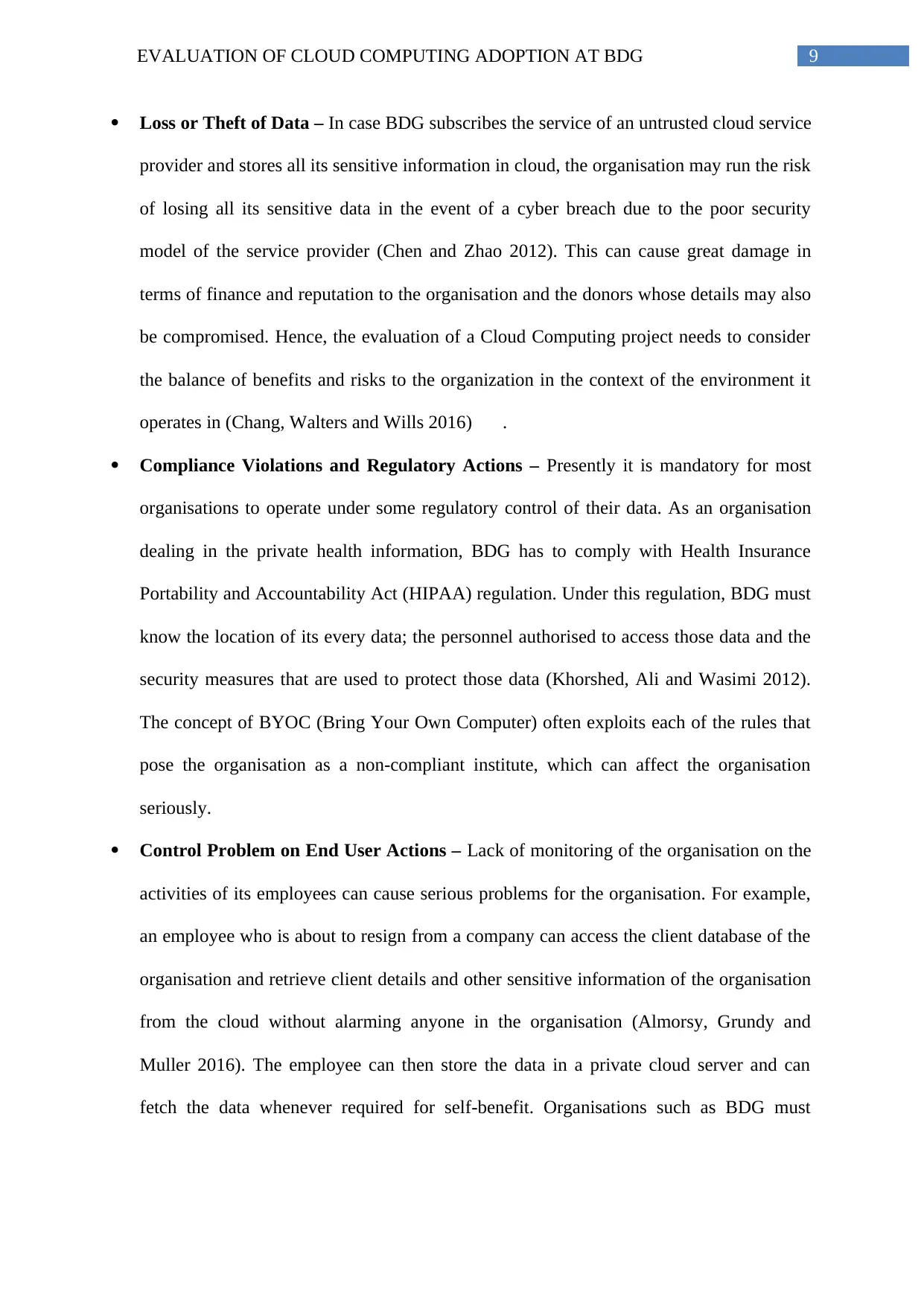
9EVALUATION OF CLOUD COMPUTING ADOPTION AT BDG
Loss or Theft of Data – In case BDG subscribes the service of an untrusted cloud service
provider and stores all its sensitive information in cloud, the organisation may run the risk
of losing all its sensitive data in the event of a cyber breach due to the poor security
model of the service provider (Chen and Zhao 2012). This can cause great damage in
terms of finance and reputation to the organisation and the donors whose details may also
be compromised. Hence, the evaluation of a Cloud Computing project needs to consider
the balance of benefits and risks to the organization in the context of the environment it
operates in (Chang, Walters and Wills 2016) .
Compliance Violations and Regulatory Actions – Presently it is mandatory for most
organisations to operate under some regulatory control of their data. As an organisation
dealing in the private health information, BDG has to comply with Health Insurance
Portability and Accountability Act (HIPAA) regulation. Under this regulation, BDG must
know the location of its every data; the personnel authorised to access those data and the
security measures that are used to protect those data (Khorshed, Ali and Wasimi 2012).
The concept of BYOC (Bring Your Own Computer) often exploits each of the rules that
pose the organisation as a non-compliant institute, which can affect the organisation
seriously.
Control Problem on End User Actions – Lack of monitoring of the organisation on the
activities of its employees can cause serious problems for the organisation. For example,
an employee who is about to resign from a company can access the client database of the
organisation and retrieve client details and other sensitive information of the organisation
from the cloud without alarming anyone in the organisation (Almorsy, Grundy and
Muller 2016). The employee can then store the data in a private cloud server and can
fetch the data whenever required for self-benefit. Organisations such as BDG must
Loss or Theft of Data – In case BDG subscribes the service of an untrusted cloud service
provider and stores all its sensitive information in cloud, the organisation may run the risk
of losing all its sensitive data in the event of a cyber breach due to the poor security
model of the service provider (Chen and Zhao 2012). This can cause great damage in
terms of finance and reputation to the organisation and the donors whose details may also
be compromised. Hence, the evaluation of a Cloud Computing project needs to consider
the balance of benefits and risks to the organization in the context of the environment it
operates in (Chang, Walters and Wills 2016) .
Compliance Violations and Regulatory Actions – Presently it is mandatory for most
organisations to operate under some regulatory control of their data. As an organisation
dealing in the private health information, BDG has to comply with Health Insurance
Portability and Accountability Act (HIPAA) regulation. Under this regulation, BDG must
know the location of its every data; the personnel authorised to access those data and the
security measures that are used to protect those data (Khorshed, Ali and Wasimi 2012).
The concept of BYOC (Bring Your Own Computer) often exploits each of the rules that
pose the organisation as a non-compliant institute, which can affect the organisation
seriously.
Control Problem on End User Actions – Lack of monitoring of the organisation on the
activities of its employees can cause serious problems for the organisation. For example,
an employee who is about to resign from a company can access the client database of the
organisation and retrieve client details and other sensitive information of the organisation
from the cloud without alarming anyone in the organisation (Almorsy, Grundy and
Muller 2016). The employee can then store the data in a private cloud server and can
fetch the data whenever required for self-benefit. Organisations such as BDG must
Paraphrase This Document
Need a fresh take? Get an instant paraphrase of this document with our AI Paraphraser
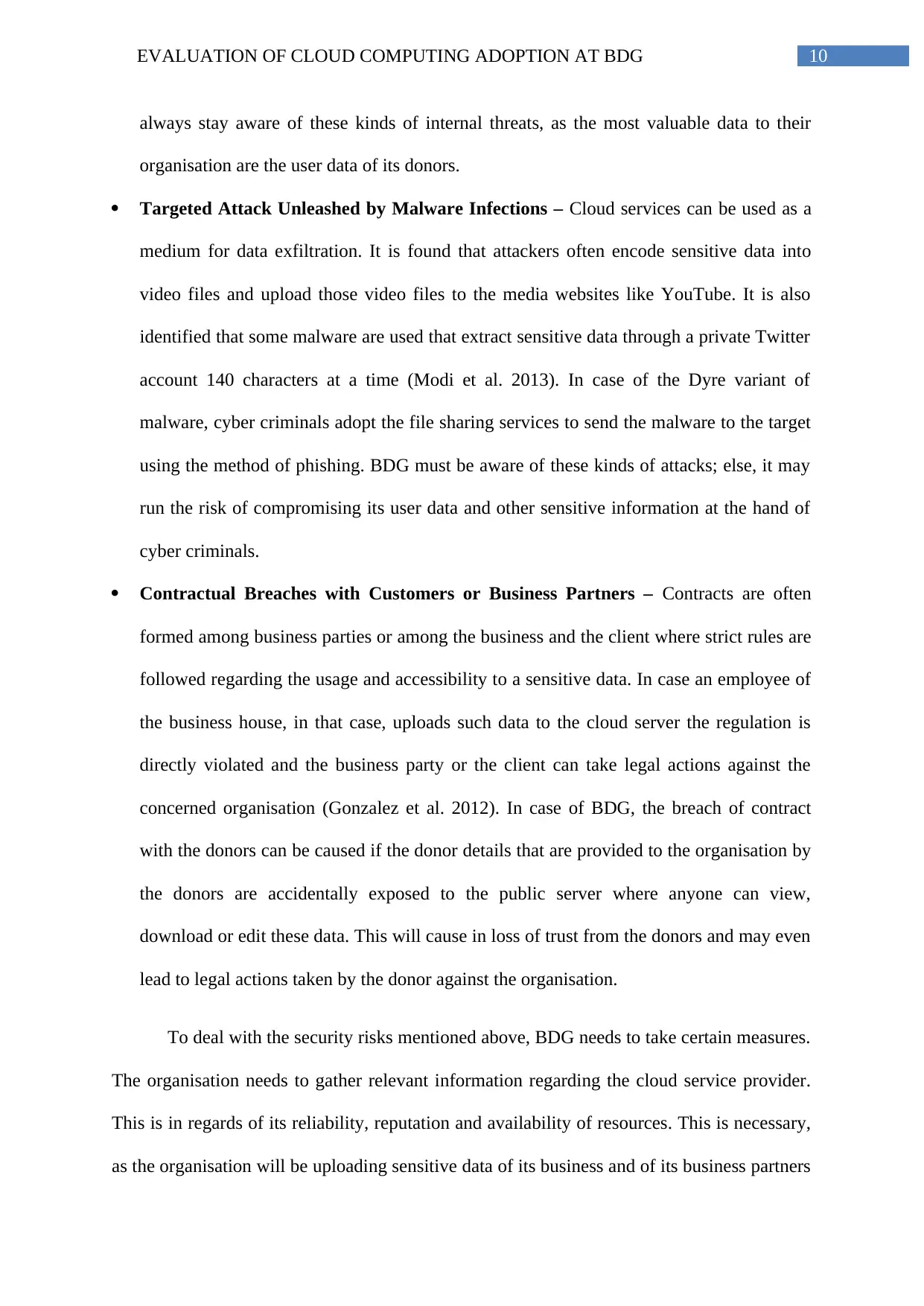
10EVALUATION OF CLOUD COMPUTING ADOPTION AT BDG
always stay aware of these kinds of internal threats, as the most valuable data to their
organisation are the user data of its donors.
Targeted Attack Unleashed by Malware Infections – Cloud services can be used as a
medium for data exfiltration. It is found that attackers often encode sensitive data into
video files and upload those video files to the media websites like YouTube. It is also
identified that some malware are used that extract sensitive data through a private Twitter
account 140 characters at a time (Modi et al. 2013). In case of the Dyre variant of
malware, cyber criminals adopt the file sharing services to send the malware to the target
using the method of phishing. BDG must be aware of these kinds of attacks; else, it may
run the risk of compromising its user data and other sensitive information at the hand of
cyber criminals.
Contractual Breaches with Customers or Business Partners – Contracts are often
formed among business parties or among the business and the client where strict rules are
followed regarding the usage and accessibility to a sensitive data. In case an employee of
the business house, in that case, uploads such data to the cloud server the regulation is
directly violated and the business party or the client can take legal actions against the
concerned organisation (Gonzalez et al. 2012). In case of BDG, the breach of contract
with the donors can be caused if the donor details that are provided to the organisation by
the donors are accidentally exposed to the public server where anyone can view,
download or edit these data. This will cause in loss of trust from the donors and may even
lead to legal actions taken by the donor against the organisation.
To deal with the security risks mentioned above, BDG needs to take certain measures.
The organisation needs to gather relevant information regarding the cloud service provider.
This is in regards of its reliability, reputation and availability of resources. This is necessary,
as the organisation will be uploading sensitive data of its business and of its business partners
always stay aware of these kinds of internal threats, as the most valuable data to their
organisation are the user data of its donors.
Targeted Attack Unleashed by Malware Infections – Cloud services can be used as a
medium for data exfiltration. It is found that attackers often encode sensitive data into
video files and upload those video files to the media websites like YouTube. It is also
identified that some malware are used that extract sensitive data through a private Twitter
account 140 characters at a time (Modi et al. 2013). In case of the Dyre variant of
malware, cyber criminals adopt the file sharing services to send the malware to the target
using the method of phishing. BDG must be aware of these kinds of attacks; else, it may
run the risk of compromising its user data and other sensitive information at the hand of
cyber criminals.
Contractual Breaches with Customers or Business Partners – Contracts are often
formed among business parties or among the business and the client where strict rules are
followed regarding the usage and accessibility to a sensitive data. In case an employee of
the business house, in that case, uploads such data to the cloud server the regulation is
directly violated and the business party or the client can take legal actions against the
concerned organisation (Gonzalez et al. 2012). In case of BDG, the breach of contract
with the donors can be caused if the donor details that are provided to the organisation by
the donors are accidentally exposed to the public server where anyone can view,
download or edit these data. This will cause in loss of trust from the donors and may even
lead to legal actions taken by the donor against the organisation.
To deal with the security risks mentioned above, BDG needs to take certain measures.
The organisation needs to gather relevant information regarding the cloud service provider.
This is in regards of its reliability, reputation and availability of resources. This is necessary,
as the organisation will be uploading sensitive data of its business and of its business partners
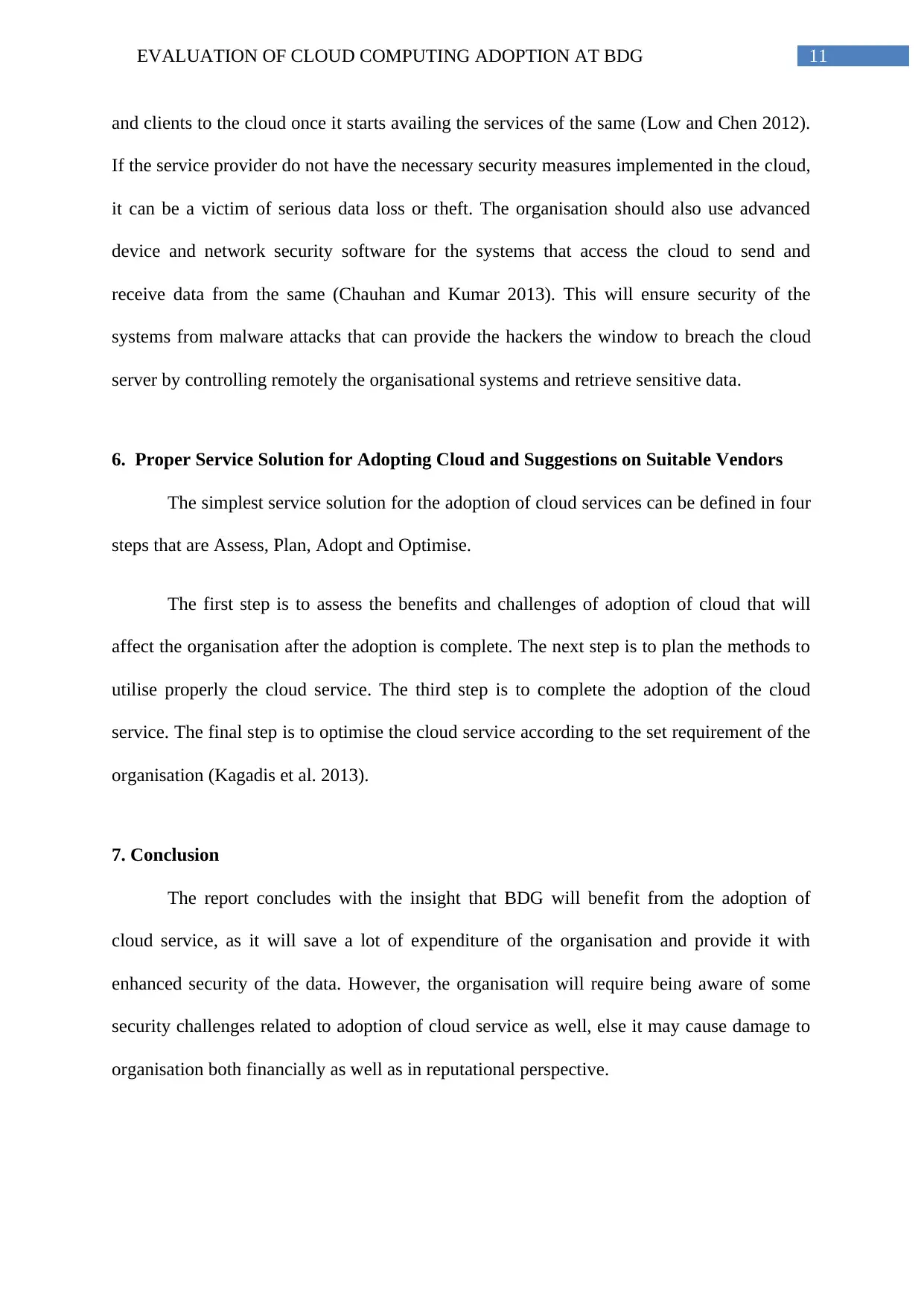
11EVALUATION OF CLOUD COMPUTING ADOPTION AT BDG
and clients to the cloud once it starts availing the services of the same (Low and Chen 2012).
If the service provider do not have the necessary security measures implemented in the cloud,
it can be a victim of serious data loss or theft. The organisation should also use advanced
device and network security software for the systems that access the cloud to send and
receive data from the same (Chauhan and Kumar 2013). This will ensure security of the
systems from malware attacks that can provide the hackers the window to breach the cloud
server by controlling remotely the organisational systems and retrieve sensitive data.
6. Proper Service Solution for Adopting Cloud and Suggestions on Suitable Vendors
The simplest service solution for the adoption of cloud services can be defined in four
steps that are Assess, Plan, Adopt and Optimise.
The first step is to assess the benefits and challenges of adoption of cloud that will
affect the organisation after the adoption is complete. The next step is to plan the methods to
utilise properly the cloud service. The third step is to complete the adoption of the cloud
service. The final step is to optimise the cloud service according to the set requirement of the
organisation (Kagadis et al. 2013).
7. Conclusion
The report concludes with the insight that BDG will benefit from the adoption of
cloud service, as it will save a lot of expenditure of the organisation and provide it with
enhanced security of the data. However, the organisation will require being aware of some
security challenges related to adoption of cloud service as well, else it may cause damage to
organisation both financially as well as in reputational perspective.
and clients to the cloud once it starts availing the services of the same (Low and Chen 2012).
If the service provider do not have the necessary security measures implemented in the cloud,
it can be a victim of serious data loss or theft. The organisation should also use advanced
device and network security software for the systems that access the cloud to send and
receive data from the same (Chauhan and Kumar 2013). This will ensure security of the
systems from malware attacks that can provide the hackers the window to breach the cloud
server by controlling remotely the organisational systems and retrieve sensitive data.
6. Proper Service Solution for Adopting Cloud and Suggestions on Suitable Vendors
The simplest service solution for the adoption of cloud services can be defined in four
steps that are Assess, Plan, Adopt and Optimise.
The first step is to assess the benefits and challenges of adoption of cloud that will
affect the organisation after the adoption is complete. The next step is to plan the methods to
utilise properly the cloud service. The third step is to complete the adoption of the cloud
service. The final step is to optimise the cloud service according to the set requirement of the
organisation (Kagadis et al. 2013).
7. Conclusion
The report concludes with the insight that BDG will benefit from the adoption of
cloud service, as it will save a lot of expenditure of the organisation and provide it with
enhanced security of the data. However, the organisation will require being aware of some
security challenges related to adoption of cloud service as well, else it may cause damage to
organisation both financially as well as in reputational perspective.
⊘ This is a preview!⊘
Do you want full access?
Subscribe today to unlock all pages.

Trusted by 1+ million students worldwide
1 out of 15
Related Documents
Your All-in-One AI-Powered Toolkit for Academic Success.
+13062052269
info@desklib.com
Available 24*7 on WhatsApp / Email
![[object Object]](/_next/static/media/star-bottom.7253800d.svg)
Unlock your academic potential
Copyright © 2020–2025 A2Z Services. All Rights Reserved. Developed and managed by ZUCOL.




